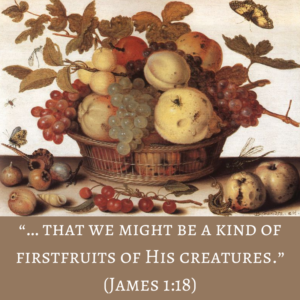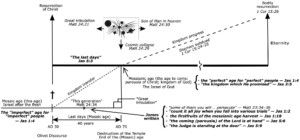
In my last post (here), I showed that James considered Christians to be the twelve tribes—the messianic-age “Israel of God” (Gal 6:16). This post will use this identity to make three related points: (1) James wrote with the idea of Israel’s “perfection” in mind; (2) the sufferings he mentions were necessary to bring that perfection; and (3) he wrote with an awareness that “the twelve tribes” (Jas 1:1) were the firstfruits of the perfection.1
In the conclusion, I will show how the inmillennial prophetic model2 helps us understand these points without robbing us modern-day Christians of their lessons.
Perfection
James wrote to the twelve tribes about perfection: “Let patience have its perfect (Gk. teleios) work, that you may be perfect (Gk. teleios) and complete, lacking nothing” (Jam 1:4). God would give perfect (Gk. teleios) gifts to enable them to do so (Jas 1:17). They were under “the perfect (Gk. teleios) law of liberty” (Jas 1:25).
Jesus and the apostles thought of history in terms of two ages. Kim Riddlebarger says, “These two eschatological ages can … be seen as the basic eschatological framework taught by both Jesus and Paul.”3 Jesus referred to these periods as “this age” and “the age to come” (e.g., Matt 12:32). For convenience, I often refer to the first as the Mosaic age and the second as the messianic age.
The apostles also thought of them as the ages of imperfection and perfection, where the term perfect means mature or complete. Paul illustrates this concept of perfection when he says, “Solid food belongs to those who are of full age (Gk. teleios)” (Heb 5:14).
In the Mosaic age, “the law made nothing perfect (Gk. teleioō), but the bringing in of a better hope did” during the messianic age (Heb 7:19 KJV). Paul (and James) speaks “wisdom among those who are mature (Gk. teleios) (1 Cor 2:6).
Paul compares the Mosaic-to-messianic age transition to a child moving to adult status:
Before faith came, we were kept under guard by the law, kept for the faith which would afterward be revealed. Therefore the law was our tutor to bring us to Christ, that we might be justified by faith. But after faith has come, we are no longer under a tutor.… The heir, as long as he is a child, does not differ at all from a slave, though he is master of all, but is under guardians and stewards until the time appointed by the father. Even so we, when we were children, were in bondage under the elements of the world. But when the fullness of the time had come, God sent forth His Son, born of a woman, born under the law, to redeem those who were under the law, that we might receive the adoption as sons. (Gal 3:23–25; 4:1–5)
To be under the law was to be a child; to be under Christ is to be a mature son.
James is writing to the “twelve tribes”—Jewish Christians—from this perspective. God had designed them to be perfect people to live in a perfect age.
If James wanted his readers to live this way during the age transition generation, how much more should we inward Jews (cp. Rom 2:28–29) live this way in the present (perfect) messianic age?
Suffering
James wanted the twelve tribes (Jewish Christians) to live perfect (mature) lives during a time of severe trials and testing (Jas 1:2–3, 12–14; 2:6; 5:10). These were not the ordinary trials of daily life.
These Christians were living in a strategic period: the “last days” of the Mosaic age (Jas 5:3), just before the coming (Gk. parousia; presence) of the Lord (Jas 5:8). He, as the Judge, was “standing right at the door” of the temple (Jam 5:9 NASB).
Jesus had explained this situation in His Olivet Discourse (Matt 24–25; Mark 13; Luke 21:5–38). The temple would fall in His presence (Gk. parousia), ending the Mosaic age (Matt 24:1–3). This judgment would come in His generation (Matt 24:34).
During this time, Christians would suffer. Speaking to apostate Jewish leaders, Jesus said He would send witnesses to them:
Indeed, I send you prophets, wise men, and scribes: some of them you will kill and crucify, and some of them you will scourge in your synagogues and persecute from city to city, that on you may come all the righteous blood shed on the earth, from the blood of righteous Abel to the blood of Zechariah, son of Berechiah, whom you murdered between the temple and the altar. Assuredly, I say to you, all these things will come upon this generation. (Matt 23:34–36)
These trials were necessary for outward Israel (cp. Rom 2:28) to “fill up … the measure of [their] fathers’ guilt” (Matt 23:32). Only then would God judge her and establish the perfect (mature, complete) messianic age.
Given this strategic situation, it’s no wonder James said, “Let patience have its perfect work, that you may be perfect and complete, lacking nothing” (Jam 1:4).
This observation does not rob us modern Christians of this lesson. We are not in the age-transition generation like James’ readers. But, the messianic age has arrived, and we live in it. God means for our testings to produce patience as we work toward our goal of making disciples of all nations during this age (cp. Matt 28:18–20).
Firstfruits
James says to the twelve tribes: “Of His own will He brought us forth by the word of truth, that we might be a kind of firstfruits of His creatures” (Jas 1:18). This is important Exodus language.
The same things were true about Israel after the flesh. Moses said, “By strength of hand the LORD brought us out of Egypt” (Exod 13:16). God said, “Israel was holiness to the LORD, the firstfruits of His increase” (Jer 2:3).
Birth imagery is here as well. God had begotten Israel after the flesh during the Exodus under Moses (Deut 32:18; Ezek 16:4). He had done the same for spiritual Israel through Christ (cp. 1 Pet 1:3; 2:9).
The twelve tribes (i.e., Christians) to whom James writes were the firstfruits of the messianic-age harvest. Modern Christians are part of that harvest, but we are not firstfruits. God reaped the initial part of His crop during the “last days” of the Mosaic age.
In Revelation, John saw these same “firstfruits.” They were the 144,000 Christians from the tribes of Israel (Rev 7:4–8; 14:1, 4). They witnessed during the “last days” of the Mosaic age, not at the end of the messianic age. James and John agree.
Conclusion
The inmillennial prophetic model affects our understanding of James’ letter. The following chart shows his conception of perfection, suffering, and firstfruits plotted on the inmillennial framework.4 References from James are in bold:

The relevance of the concepts to the twelve tribes in James’ day does not rob us of them. We take part in the same “perfection” as they did. Their sufferings were to fill up apostate Israel’s sins, but ours are to advance the kingdom and make disciples of the nations. We are not firstfruits of the messianic-age harvest, but we are part of the harvest to which their ingathering pointed.
We can plot these concepts and their application to James’ generation onto the inmillennial prophetic model without modification.
Footnotes
- The image in this post is Fruit Basket by Balthasar van der Ast (1593/1594–1657). This file (here) is in the public domain (PD-US).
- For a full-length account of this prophetic model, see Michael A. Rogers, Inmillennialism: Redefining the Last Days (Tullahoma, TN: McGahan Publishing House, 2020). It is available here. For a summary, see the free PDF here.
- Kim Riddlebarger, A Case for Amillennialism: Understanding the End Times (Grand Rapids: Baker, 2003), 89.
- I show the incremental development of this model in Rogers, Inmillennialism. The full model appears on page 263.

2 comments
I like what you have written here. Helps me to understand some of James’ terms. Thanks Mike.
Ian — Thanks for this encouraging message! — Mike